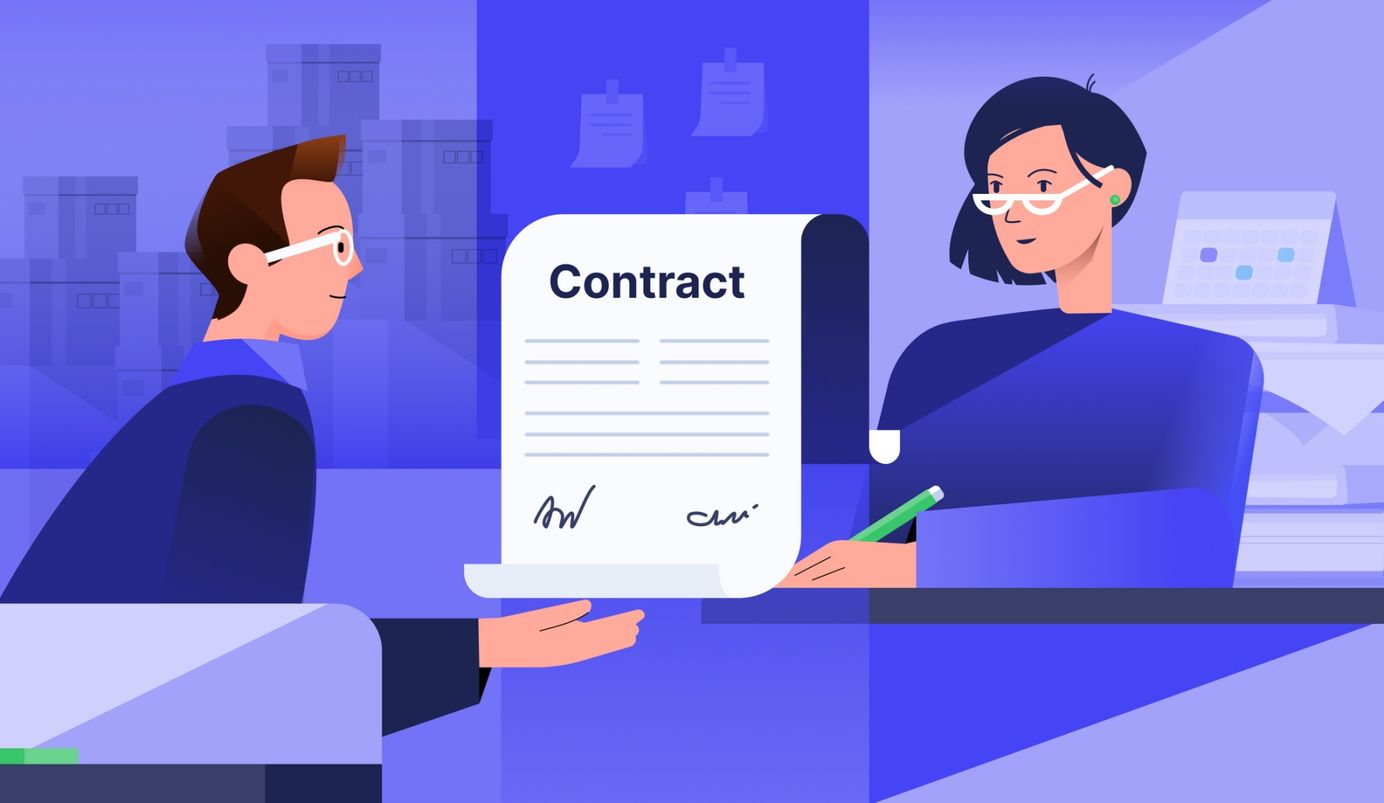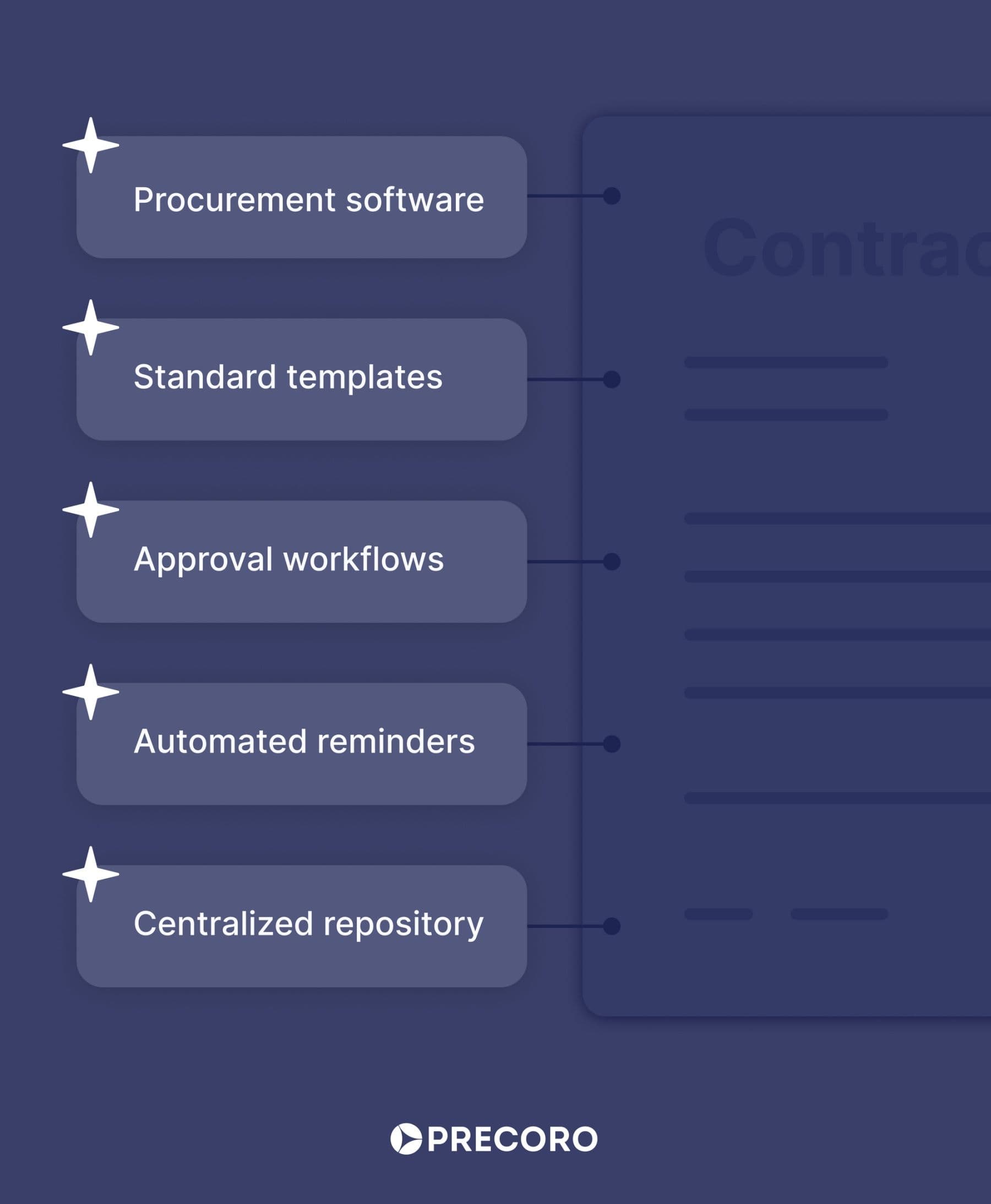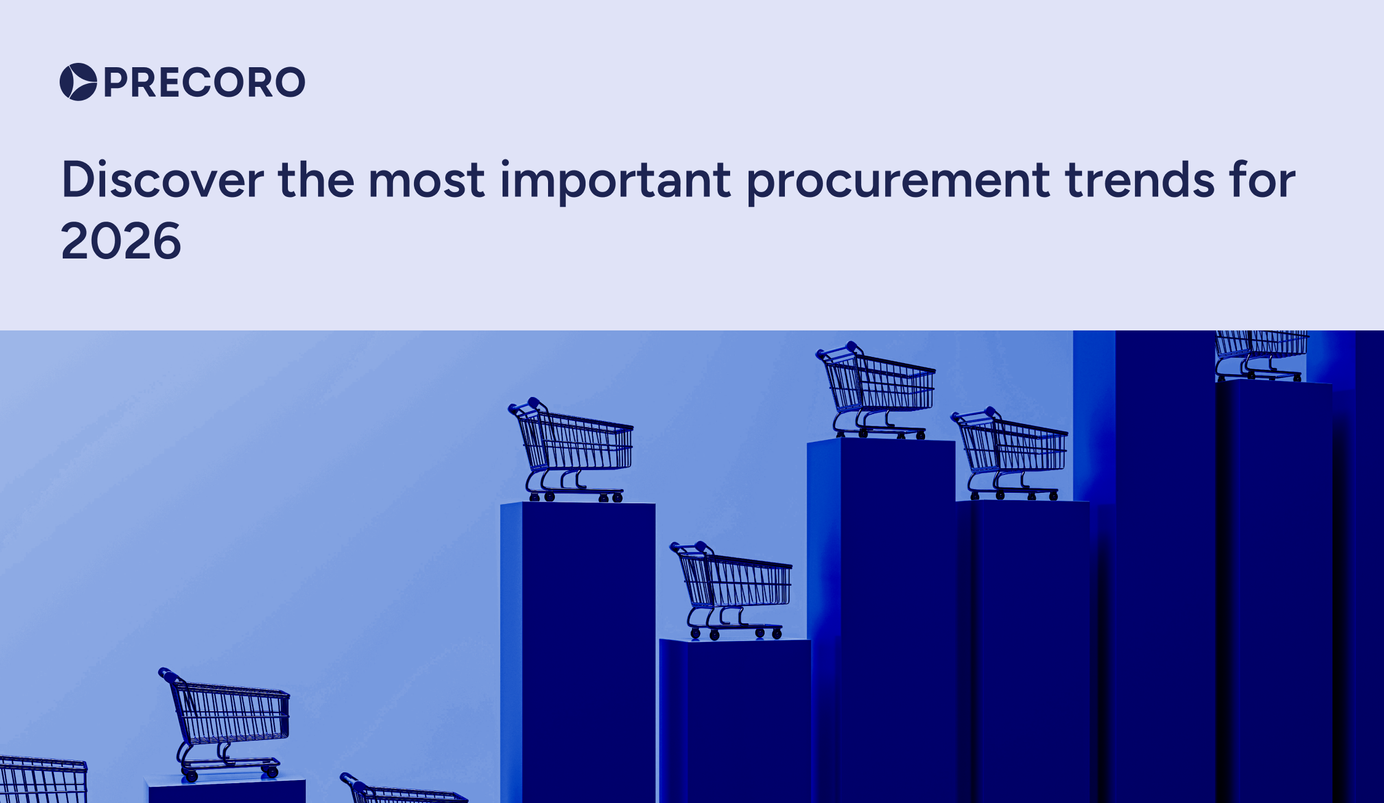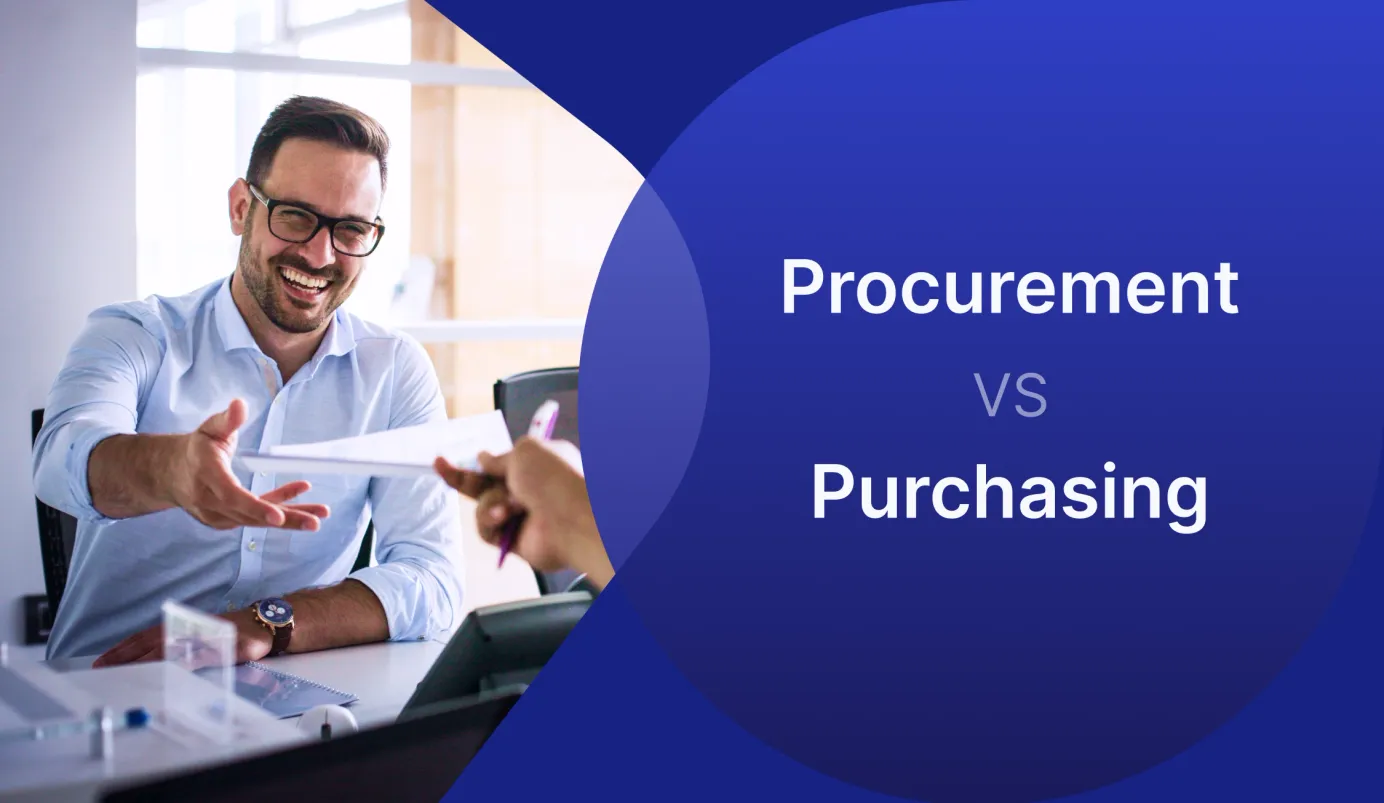
16 min read
Understanding Procurement Contracts
No matter how great your procurement process is, bad purchasing contracts can leave you stuck in the mud. Learn how to tread smoothly when it comes to procurement contracts.
Regardless of size or industry, every organization relies on procurement to achieve its objectives and stimulate growth. Procurement, the art of acquiring goods and services, is not just an option but a fundamental requirement for businesses to function smoothly.
An effective procurement contract strengthens business relationships by clearly protecting the interests of both buyer and seller. It sets out all agreed-upon details (such as material quality, service scope, delivery schedules, fees, and costs) and provides a solid foundation for trust and successful collaboration.
Efficient management of procurement contracts is also paramount to meeting production needs, mitigating risks, and achieving significant cost savings. In this article, we will explore the essence of procurement contracts and discuss how businesses can optimize their management. We will:
- Go over the basic definition of procurement contracts;
- Describe what a contract should include;
- Map out the contract types;
- Talk about streamlining the procurement contract process;
- Discuss the possible challenges of procurement contract management;
- And highlight ways to streamline contract management;
- Go over the frequently asked questions.
What is a Procurement Contract?
A procurement contract is a legally enforceable agreement between a buyer and a seller. It outlines the responsibilities and obligations of both parties and ensures that terms such as quantity, quality of goods, delivery schedules, and payment conditions are clearly defined and properly fulfilled.
It serves as the framework for the entire procurement process, ensuring that what was initially discussed and agreed upon is fulfilled. Types of procurement contracts can vary, but the overarching theme of them is that they should all define transaction terms and ensure that both parties are on the same page.
Procurement professionals dedicate substantial time to sourcing vendors, engaging in negotiations, and guaranteeing adherence to internal regulations. The final effectiveness of these efforts hinges on the seamless execution of procurement contracts.
The Significance of Procurement Contracts in Business Relationships
Procurement contracts are the backbone of business relationships between a buyer and a seller. They offer a structured, legally binding framework for transactions. Procurement contracts are more than just documents — the complexity of the procurement process amplifies the importance of contracts as instruments of trust, risk management, and clarity in the dynamic procurement world.
When it comes to business transactions, these legally binding agreements, with outlined details of every step, provide essential security. Both buyers and suppliers depend on each other for the smooth functioning of their operations. And procurement contracts create confidence for both parties, assuring that the seller will deliver goods or services and the buyer will guarantee compensation for fulfilled promises. Understanding the intricacies of these contracts is crucial for effective small business financial management.
The Comprehensive Framework of a Procurement Contract
A procurement contract is a multifaceted agreement that provides the framework for business relationships between procurement partners. To effectively manage and understand procurement contracts, it's imperative to have a comprehensive grasp of their key components. Let's see what they are.
Defining the Scope of Work
One of the foundational elements of a procurement contract is the description of the scope of work. This section explicitly outlines the goods or services to be provided. It should specify quantities, quality standards, and any specific requirements. Clarity in the scope of work sets the stage for a successful contract execution.
Pricing and Payment Terms
Pricing and payment terms are integral to any procurement contract, as clarity in financial matters is essential for budget planning and transparency. This section addresses the pricing structure, including unit prices, discounts, and payment terms. If relevant for the project and the contract type, the total price can also be stated right away.
To facilitate financial planning, it is important to ensure transparency regarding when and how the buying company will make the payments. So the section should also describe the payment method (e.g., lump-sum, installments), payment processing (e.g., direct credit, checks), and key payment dates.
Delivery or Performance Monitoring
The timeline for item delivery or service provision is another crucial aspect. Defining milestones and deadlines is essential for monitoring progress effectively. This information ensures that both parties are aligned in their expectations.
General Terms and Conditions
Terms and conditions of cooperation should always be detailed in a procurement contract. This section describes warranties, communication channels, confidentiality clauses, and other additional operational conditions. These contractual obligations dictate how the parties must address potential issues and conflicts that may arise during the contract's execution.
Risk Management and Legal Compliance
Identifying potential risks and liabilities is a fundamental part of any contract. Within the contract, establishing mechanisms for addressing these risks, such as insurance requirements or penalties for non-compliance, ensures that the contract is resilient in facing unforeseen challenges.
Additionally, compliance with relevant laws and regulations is essential to avoid legal complications. Outlining the compliance principles is especially important for international transactions when domestic regulations might differ.
Contract Completion and Termination
Contracts have a lifecycle, and defining the terms and conditions for contract termination or closure is important. The contract may end upon fulfilling its requirements or due to differences of opinions or other issues.
Some contracts are perpetual and only terminate based on specified conditions, while others have a defined time frame. This section clarifies the contract's duration and exit strategy for the parties.
Dispute Resolution
A well-structured procurement contract includes a straightforward process for dispute resolution. It outlines the steps both parties should take to resolve any issues amicably and specifies the legal procedure when a peaceful resolution is impossible. Alternative dispute resolution strategies become particularly critical in international transactions, and within the contract it should be clear under which jurisdiction disputes are to be settled.

Navigating the Types of Procurement Contracts
There are various types of contracts to suit different business needs, objectives, and risk profiles. Understanding these contract categories is essential for informed decision-making in procurement. Now, let’s explore the main types of procurement contracts and shed some light on their nuances and suitability for different scenarios.
1. Fixed-Price Contracts
Fixed-price contracts, or lump-sum contracts, are the most straightforward of all procurement agreements. They establish a set price for goods or services based on a predefined scope of work. The defining characteristic is that the price remains constant throughout the contract's duration, regardless of supplier cost fluctuations.
These contracts are ideal for well-defined projects with minimal scope changes and for essentials that must be purchased regularly. In other words, a fixed-price contract guarantees the buyer a specific price in return for the guaranteed minimum order quantity.
With the fixed-price contract, the supplier bears the risks of possible cost overruns. Suppliers cannot actively change the agreed upon price due to cost fluctuations, so under the fixed-price contracts it is in their best interest to strive for cost-effective performance.
With this type of procurement contract, the buyer benefits from consistency, as the vendor will continue to provide the same services for the same price regardless of the circumstances on their side. On the other hand, buyers should establish clear and strict quality control guidelines to ensure that suppliers dont decrease the quality of the product in order to retain profits.
Fixed-price procurement contracts can be broken down into 3 more types, specifically:
- Firm fixed-price (FFP) — the most basic kind. The seller must complete the job within the previously agreed terms and for the previously agreed compensation. For example, this approach is often used for government and semi-government contracts, where each cost should be strictly predefined long ahead.
- Fixed-price and incentive fee (FP-IF) — the kind of contract under which the buyer pays an incentive fee when the seller performs well. There's still a fixed price for the job completed or goods delivered. However, if the supplier's performance exceeds expectations, the supplier is entitled to receive the incentive payment defined in the contract. FP-IF contracts lower the seller's risk and are often used when the relevant supply is scarce and the buying company wants to secure the deal.
- Fixed-price with economic price adjustment contract (FP-EPA) — the kind of procurement contract that operates with a fixed price but allows for adjustments according to the market situation. The FP-EPA contract accounts for inflation and an increase in the production cost. Like with every fixed-price contract, the seller and the buyer agree on the scope of work or quantity of goods that will be provided for the specified price.
However, the final price can be adjusted if the production costs go up due to factors out of the seller's influence. Contracts with economic price adjustment options are typically used for longer, multi-year cooperation when the seller needs added leeway to adjust for inflation.
2. Cost-Reimbursable Contracts (or Cost-Disbursable)
With a cost-reimbursement contract, the buyer reimburses the seller for allowable costs, such as materials, salaries, and utilities, and adds a fee for the seller’s work. These contracts are suitable for when the project's scope cannot be defined precisely before the start, and there is substantial uncertainty about the final cost. The buyer and the seller estimate costs for the sake of budgeting, but the actual final cost might differ, often within a tolerance limit established in the contract.
There are several kinds of the cost-reimbursement contracts:
- Cost plus fixed fee (CPFF) — under such a contract, the seller is paid for all incurred costs plus a fixed fee, irrespective of cost performance. CPFF contracts are employed in high-risk projects where attracting bidders is challenging. This contract protects sellers from risks as the procuring organization assumes all risks.
- Cost plus incentive fee (CPIF) — the kind of contract in which the buyer assumes the risk, but it is mitigated by an incentive offer based on performance objectives outlined in the contract. The fee is generally predetermined and typically represents a percentage of the savings resulting from the seller's performance.
- Cost plus award fee (CPAF) — these contracts involve an incentive fee based on the buyer's evaluation of how well the seller met the contract's performance objectives. This is a subjective evaluation, and the contract language must be clear about its limits. The contract should specify that the seller will receive an award of up to a certain dollar amount for meeting or exceeding job requirements outlined in the terms.
- Cost plus percentage of cost (CPPC) — with this kind of contract, sellers are paid for all costs incurred, along with a percentage of these costs as profit. This contract type incentivizes sellers to increase their actual costs to earn higher profits, which can pose challenges if not carefully monitored.
3. Time and Materials Contract (T&M)
Time and materials contracts combine elements of fixed-price and cost-reimbursement contracts. They require payment for actual time spent and materials used, often with predefined labor rates and material markups. These contracts are suitable for projects with evolving requirements or unclear scopes.
T&M contracts are typically used when sellers provide labor, and risk is shared between both parties involved. These contracts are suitable for hiring outside vendors and experts, with sellers submitting hourly rates for their services. It's crucial to set limits to avoid budget overruns.

Streamlining the Procurement Contract Process
In the fast-paced realm of procurement, efficiency is paramount. To expedite operations, procurement teams often employ templated contracts, which they generate using contract management platforms. These templates are then edited to suit specific terms and supplier details, allowing teams to hit the ground running. The typical procurement contract management process unfolds as follows:
Identify the Scope of Work and Requirements
The process begins with the project management team identifying the needs for materials, services, staffing, and other resources required for a project. These needs are then communicated to the procurement team, typically in the form of a purchase requisition.
The procurement team inquires in detail about all the specific requirements for goods and services they will be purchasing. This communication between project management and the procurement team should result in a clearly defined scope of work with a detailed description of everything required for its execution.
Solicit Bids
The procurement team, armed with the project requirements, researches available vendors and suppliers to select those who have the potential to meet the company’s needs. The procurement team then initiates the process of soliciting bids from potential vendors.
If it’s not the first time purchasing such goods or services, the procurement team can draw ideas from the previous purchases and adjust for the current context. If the procurement team will be dealing with a new type of purchase order, they might start with issuing requests for information to different vendors and suppliers in order to map out the market.
When the scope of work is defined and the procurement team has an idea about the cost estimation, they can issue a request for proposal (RFP) or request for quotation (RFQ) based on the company’s needs. The business issues the RFP if they have a problem and don’t have a solution yet, and would like the potential vendors to offer the action plan. And when the procurement specialists know exactly what they need and just need to inquire about the price options, they issue an RFQ.
Select Proposal
The suppliers and vendors then review the company’s request and send their solutions or quotas — so-called bids. After receiving and assessing multiple bids, the procurement team selects a proposal that aligns with their requirements and objectives and offers the most value for the best price.
Draft a Contract
A procurement contract is then drafted. It is either generated from the template – in case of a standard procurement situation – or prepared from scratch for the unique cases. If the contract is drafted from a pre-approved template, the procurement manager can quickly fill in the necessary information and move on to the next step of communicating it to the supplier.
However, if the contract is prepared from scratch, the procurement team needs to communicate with the legal department. Together they ensure that the newly created agreement has all the necessary information and is compliant with the legal requirements and regulations.
Approve the Contract
When the draft is ready, it undergoes approval: first by the relevant leadership within the purchasing company and then by the selling partner. The approval process often requires several rounds of back-and-forth communication between the potential buyer and supplier in order to raise any concerns or comments and align all the expectations.
This can happen via email, on a shared online drive, or in a dedicated supplier management software accessible by both parties. When all the details are agreed upon, both parties sign the contract, thus formalizing the agreement.
File the contract
After the contract is signed, the procurement team archives it and stores it for future reference. In many cases, the contracts are just left in emails or filed away as printed copies and not referred to unless there’s a problem with the execution. That is, of course, not ideal, and can result in losing the contracts or missing out on opportunities to analyze them while preparing future agreements.
On the other hand, storing contracts in a dedicated repository makes any documentation accessible as soon as needed and allows the procurement team to easily extract valuable data. Information from the procurement contracts, when analyzed properly, can offer invaluable insights into supplier relationships and the purchasing process. This info, in turn, helps the procurement team make informed decisions during further negotiations and improve their contracting process with every iteration.
It’s also possible that the parties will have to refer to the contract to solve possible problems and disputes. In such cases, they’ll need to locate the relevant contracts promptly, and if they don’t do so they could face serious financial or even legal consequences.
Execute Purchasing Process
With the contract in place, the buyer initiates the purchasing process, also known as a purchase-to-pay or P2P cycle. It involves placing an order (often by issuing a purchase order via PO software), overseeing delivery, inspecting the goods delivered or services provided, conducting three-way (or two-way) matching, and paying for the order.
Conclude the Contract, Evaluate, and Review
When all the obligations on both sides are fulfilled, the contract concludes. Some contracts may include a guarantee clause, wherein the seller guarantees the product's quality for a specified period before contract closure.
Procurement leadership can then coordinate with the project manager to review and evaluate the cooperation with the particular supplier under the specific contract. If there’s good feedback regarding the supplies and involved procedures, the procurement team will most likely consider working with the supplier again in the future. If there were some serious setbacks, management should analyze them as a preventive measure, under their risk-management strategy.

Be Aware of the Challenges
Managing procurement contracts presents its own set of challenges. It's not always easy to manage contracts consistently, as each business partner might present their own set of demands and criteria. That becomes especially challenging if the company has to work with many suppliers and vendors simultaneously.
There are several typical challenging aspects of procurement contract management. By keeping them in mind while reviewing the company practices, managers can minimize the possible complications.
Vendors and Contract Requirements
Effective communication between the contract manager and the project manager is essential to define deliverables, quantities, and timelines. This often involves input from various departments, which can complicate the approval process. Implementing a contract tool with online access and approval workflows can streamline this phase.
Drafting Consistent Contracts
Contracts drafted by procurement teams can sometimes lack consistency, as they may not use pre-approved language and contract terms. This can introduce risks and liability. Automating contract templates specific to procurement contracts can mitigate discrepancies and errors.
Negotiation Challenges
Contract negotiation often involves back-and-forth exchanges of contract versions between parties, leading to lengthy and resource-intensive processes. Specialized legal software that enables real-time negotiation and redlining can expedite this phase.
Signing the Contract
The duration of this phase varies depending on whether wet ink signatures or electronic signatures are used. The manual workflow with wet signatures and multiple tools can be cumbersome. Embracing eSignature solutions streamlines this process, particularly for cross-border transactions.
Post-Signature Compliance Management
After signing, procurement contracts are typically archived and underutilized, leading to missed opportunities for data analysis and improvement. Storing contracts in a dedicated contract repository allows for the extraction of valuable data to inform future contracts and enhance the overall contract management process.
A Few Tips for Managing Procurement Contracts Like a Boss
Procurement contract management is quite a complex process that requires considering numerous internal needs and regulations, as well as external factors. As a result, it can become quite an overwhelming task.
To streamline the procurement contract management process, make it more efficient, and reduce the risk of errors or delays, procurement management can consider the following tips.
Implement Digital Contract Management Software
Invest in digital contract management software specifically designed for procurement. This software can help you centralize contract storage, automate workflows, and improve contract visibility. It also allows for easier tracking of contract milestones and deadlines. Procurement automation software can take the company's purchasing efficiency to the next level. To give it a try with your company's specific case, contact the Precoro team for a demo.
Standardize Contract Templates
Develop standardized contract templates for common procurement scenarios. This can include standard terms and conditions, pricing structures, and legal clauses. Standard templates ensure consistency and reduce the time required to create new contracts from scratch.
Streamline Approval Workflows
Create well-defined approval workflows for contract review and authorization. Ensure that the right stakeholders are involved in the approval process, and use digital tools to facilitate document sharing and electronic signatures. This will speed up the approval process and reduce bottlenecks.
Use Automated Reminders
Implement automated contract reminders to notify relevant parties of important contract milestones, such as renewal dates, performance evaluations, or termination notices. These reminders help prevent missed deadlines and ensure contract compliance.
Establish a Centralized Repository
Maintain a centralized contract repository where all contracts are stored and easily accessible. This repository should be well-organized, allowing users to search for and retrieve contracts quickly. It also helps in auditing and reporting.


Frequently Asked Questions
A procurement contract (sometimes called a purchase contract), is a legally binding agreement that outlines the commitments and obligations of both the buyer and supplier.
The main difference between the two documents is their duration. While a procurement contract outlines general terms of cooperation between the buyer and seller, a purchase order is a document sent by a buyer to an external supplier to confirm the intention of purchasing specific goods or services.
There are various types of contracts to suit different business needs, objectives, and risk profiles. The main types are the following: fixed-price contracts, cost-reimbursable contracts, and time and materials contracts.
In Conclusion
A procurement contract is a meticulously structured agreement that serves as a guiding framework for the sellers and buyers, ensuring that both parties are aligned in their expectations and obligations. Understanding the diverse landscape of procurement contracts is crucial for selecting the most suitable contract type for your organization's needs. Each variation comes with its own unique advantages and disadvantages.
The choice of contract should align with factors such as project needs, budget constraints, and the level of certainty regarding the scope of work. By navigating these contract options effectively, businesses can optimize their procurement strategies, build mutually beneficial partnerships with suppliers, mitigate risks, and ensure that their procurement processes run smoothly and efficiently.
To enhance the procurement journey and yield better results, companies should implement consistent templates, introduce clear approval workflows, and improve communication with their vendors and suppliers. All that can be achieved by finding the right automation tool that will consolidate and simplify contract management operations.









